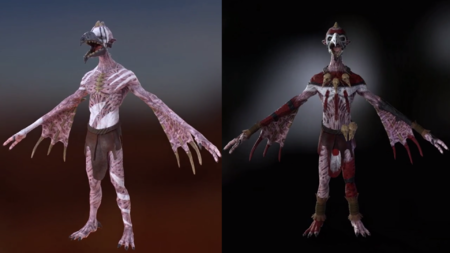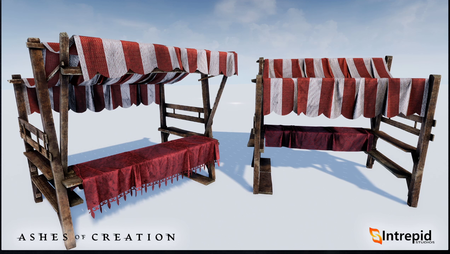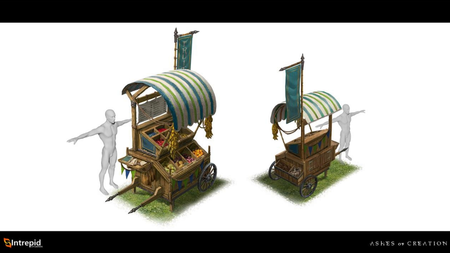Diferenças entre edições de "NPCs"
(Add image) |
(Remove draft) |
||
| Linha 1: | Linha 1: | ||
| − | |||
| − | |||
[[File:bird people.png|450px|thumb|[[Pre-alpha]] Sladeborne [[NPCs|NPC]] [[Races|race]]. This was a once-beautiful race of cloud-dwelling bird people who were struck by a calamity long ago.<ref name="livestream-3-September-2017-15:40">[https://youtu.be/L30qJOqZUAg?t=15m40s Livestream, 3 September 2017 (15:40).]</ref>]] | [[File:bird people.png|450px|thumb|[[Pre-alpha]] Sladeborne [[NPCs|NPC]] [[Races|race]]. This was a once-beautiful race of cloud-dwelling bird people who were struck by a calamity long ago.<ref name="livestream-3-September-2017-15:40">[https://youtu.be/L30qJOqZUAg?t=15m40s Livestream, 3 September 2017 (15:40).]</ref>]] | ||
Revisão das 20h43min de 30 de novembro de 2017
Reputation
NPCs react differently to players based on their contributions to a node.[2]
NPCs will add a player to their hate list if that player heals, buffs or otherwise assists any player on their hate list.[3]
Desenvolvimento de Base
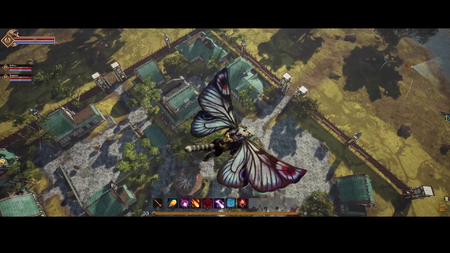
Já no terceiro estágio de evolução, como uma vila, é um layout razoavelmente grande; e parte desses layouts inclui domicílos essencialmente estáticos, dentro da base, que os jogadores podem comprar.[4] – Steven Sharif
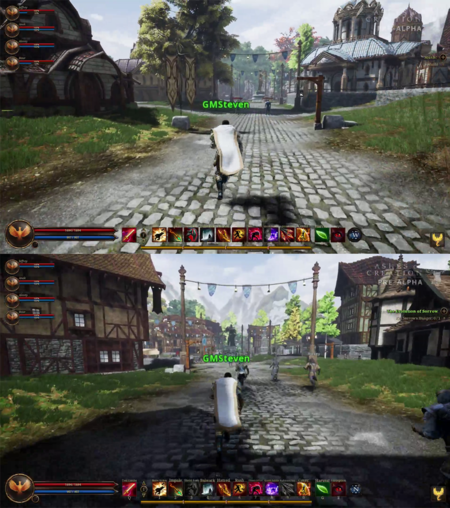
O layout e a arquitetura dentro da área de desenvolvimento de uma Base são determinados pela raça com mais influência. Por exemplo, uma Base em estágio 3 onde a maioria dos jogadores contribuíntes é Py'Rai terá uma vila Py'Rai com arquitetura Py'Rai. A maioria dos PNJs seriam elfos Py'Rai, e ofereceriam missões com narrativa Py'Rai.[6] – Margaret Krohn
A experiência contribuída por cada jogador é marcada com sua raça e outros identificadores. Quando uma Base evolui, a raça com a maior contribuição de experiência determina o estilo e cultura da Base. Essa mudança de estilo e cultura pode ocorrer em todo Estágio de Base. Por exemplo, se uma Base avança para o Estágio 2 - Acampamento e 51% de toda a experiência veio de jogadores Ren'Kai, a Base será uma Base Ren'Kai Estágio 2. Se essa mesma Base avançar para o Estágio 3 - Vilarejo, mas dessa vez os Py'rai tiverem contribuído 62% de tpda a experiência obtida, a Base se tornará uma Base Py'Rai Estágio 3. Influências culturais trazem mudanças além da estética e das missões - benefícios são dados àqueles da cultura dominante dentro da Zona de Influência daquela Base.[7] – Margaret Krohn
O layout e o estilo de uma Base são determinados por diversos fatores:[8]
- Localização da base.[8]
- Tipo de Base.[8]
- Raça que mais contribuiu para a evolução da Base.[8][9]
- Aparências raciais dos prédios e dos PNJs de uma Base.[10][9]
- Isso se aplica a todas as bases, incluindo bases de castelo.[11]
- O resto é determinado pelo prefeito da base.[8]
Algumas partes são determinadas pela área onde a base está. Outras, pelo tipo da base; certas partes são determinadas pela raça, e o resto é determinado pelo prefeito.[8] – Jeffrey Bard
Todas as bases, sejam elas relacionadas aos castelos ou não, têm influências culturais que são replicadas nas aparências dos prédios e dos PNJs presentes na Base.[11] – Steven Sharif
Existe uma mecânica de atrito que afeta a experiência e influência para impedir que uma única raça domine o mundo inteiro.[12]
Existe um atrito e esse atrito na experiência e influência aumenta de acordo com a performance da raça no mundo. Então se todas as bases forem de Orc, o nível de atrito deles será muito alto para competir com outras raças na hora de estabelecer a cultura de novas bases. Isso acontece pois já são muito influentes e existe uma opinião popular contra eles nas regiões que não influenciam.[12] – Steven Sharif
Quiósques de jogador
Quiosques de jogadores (também chamados de vendas e tendas de aluguel) são áreas locáveis próximas à edificação única em uma base mercantil[15] ou em Mercados (a edificação "construível" que prefeitos podem instalar em qualquer base
[[{{{2}}}]] (estágio 4) ou maior.[16]
Todas as bases tem a habilidade de criar quiosques de jogadores. Se você não é de uma base mercantil e não tem um empório - sua edificação única - então você pode construir um o que eu chamaria de um mercado; e esse mercado virá com um certo número de serviços e um certo número de quiosques. Se bem me lembro, uma base mercantil tem a habilidade de construir uma casa de leilão, que oferece a possibilidade de listar e vender itens, e esse tipo de base também inclui mais espaço para quiosques de jogadores.[16] – Steven Sharif
Alugar um quiosque de jogador permite que os jogadores vendam itens e disponibilizem serviços de reparo e encantamento, mesmo que não estejam online.[17]
- Quiosques de jogadores poderão ser utilizados por um período de tempo, dependendo do preço pago ao alugar o quiosque.[17]
- Um atendente será responsável pelo quiosque.[17]
- Quadros de mensagens que listam os itens disponíveis em quiosques de jogadores podem ser acessados de qualquer lugar na região.[18]
- Eles oferecem a localização do quiosque para que os jogadores possam viajar até lá e comprar os itens.
- Itens de quiosques também serão listados em casas de leilão.[19]
- Os jogadores poderão colocar os itens que precisam de reparo e também comprar os materiais necessários para o mesmo se o quiosque estiver vendendo.[20]
- Os jogadores não podem ser atacados enquanto ocupam um quiosque.[21]
- Quiosques de jogadores podem ser alugados por cidadãos de uma base.[19]
Quiosques de jogadores são diferentes de lojas pessoais e casas de leilão.[19]
Siege mechanics
A siege occurs over several phases.[22]
- Certain siege mechanics may be gated for specific size groups during sieges.[23]
- There will not be a deserter debuff for leaving a siege before it is complete.[24]
- More will be revealed in an upcoming blog entry.[22]
Farmhands and NPC assistance
Based on node type and progression, players will be able to hire NPCs to work as farmhands on their freehold farms.[25] Players will be able to command these farmhands in-game as well as potentially offline via an application (mobile app) or web interface.[25][26][27]
Day/night cycle
Transportation of goods
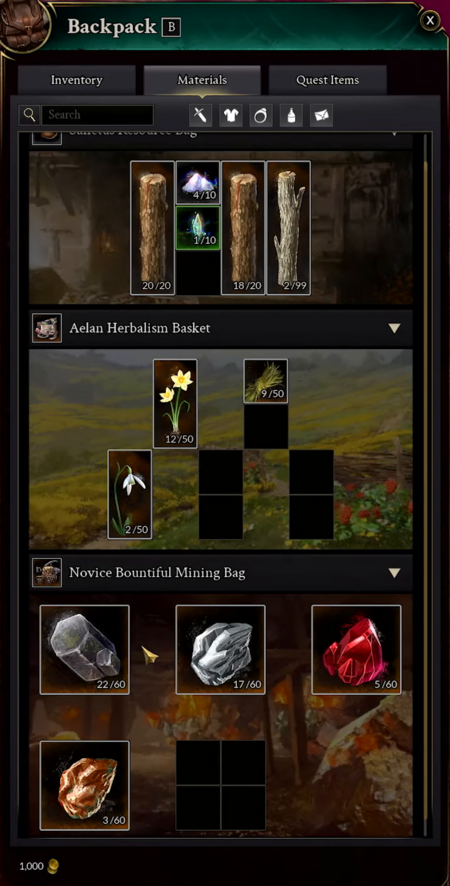
Inventory for A2 will exist in two categories, spatial and non-spatial. The spatial inventory system will only exist for materials and gatherables. The non-spatial system will be the normal single slot inventory that is used for all completed items IE gear, consumables etc.. The spatial system is intended to provide limitation and progression when everything in the open world is gatherable, requiring players to strategize which things they choose to gather or not. These spatial inventories will be shaped in various ways that make the bag types more conducive for certain types of gatherables allowing players to specialize their capacity. Auto sort is a feature[29] – Steven Sharif
Inventário capacity has quantity (stacking) limits based on the type of item.[30][31] Backpacks offer varying stack sizes and/or spatial inventory shapes that are optimized for carrying different items.[32][33]
- A player's inventory has sections for different types of items.[34] Quest items for example will not fill a player's regular inventory capacity.[35]
- Materials and resource bags have spatial ("Tetris" style) slots for items with different shapes and sizes.[36][29][37][38][39]
- The spatial inventory system is intended to mitigate the potential for players to diminish land management scores by stripping resources from particular zones as well as provide a challenging gameplay layer for players.[36][40]
- Inventory is split into two separate management systems. The first is your non-material, non-gatherable slots. Those are your standard single slot, not-space-constrained system that's a standard inventory: you just have a single slot, and you can pull completed items and/or consumables and quest items or whatever into that slot. And then, when you're talking about materials, specifically processed goods and gatherables: those exist within the Tetris type uh inventory system.[37] – Steven Sharif
- All those materials actually sorted nicely in the appropriate bags based on your stack sizes.[28] – Alex Khudoliy
- There will be a healthy number of slots for gear in a player's inventory.[41]
- Completed item inventory slots are not space constrained (by the tetris system).[37]
- Completed items, such as gear are also not subject to weight limits.[41]
- Gear loadouts can be swapped using a hotkey when out of combat.[41][42][43]
- Inventory capacity will be relatively limited for new characters.[35] Additional capacity may be increased by obtaining higher quality backpacks from crafters.[44][37][30]
- We want to have very unique progression when it comes to the construction of resource bags; and those resource bags will have certain benefits, like increasing stack size count of particular types of resources; or of having a additional delay time necessary to interface with with your corpse, should a player try to take the resources you might have dropped in PvP; or having passive benefits and unique structures of spacing that makes it more a better bag for wood gathering because woods are three-by-one; or a better bag for mining because mining is always two-by-two. The idea is to make your intent as a gatherer when you go out into the wild specific right not just that you're going out into the wild and gathering everything you can because it's there; and that's what we don't have like a labor system that limits it. We have a space constraint system so when you leave your node and you go out into the wild you need to be conscientious of what you're choosing to interact with and take resources for, because you have a limited space constraint to that degree.[37] – Steven Sharif
- Inventory capacity is subject to quantity rather than weight limits.[30]
- In my opinion, and this is of course subjective, but weight management is not a compelling mechanic for players to have to deal with in an MMO setting.[30] – Steven Sharif
- Players will have the ability to search for items they have stored in various locations (such as personal storage and node warehouses).[45]
- We want you to know where the things are; and then the meaningful aspect of that thing is traveling to those locations to access some of those things, particularly as it relates to materials and raw gatherables.[45] – Steven Sharif
- Inventories will be able to be sorted.[29]
- Q: Why did you go for a spatial inventory system for resources?
- A: There's a number of different methods that we can use in an effort to mitigate, or again throttle, the amount of success that players can have in any one trip out in the world. Now, we're using a combination of three things: We are using progression gating through your profession level; so you need to have a certain level to access certain resources. We are utilizing the spatial inventory space as a limitation on how much things you can gather before you need to go back to town. And then lastly we have a tool predicate where you need to have a tool that is relevant for the resource you're gathering; and those tools have a decay value after each use. Weight is obviously an approach that we could take if we wanted to limit. However, the spatial system works in concert with a number of other types of systems. For example, we want to have itemization drop on death specifically as it relates to material items; and we want there to be an additional layer above just weight that introduces complexity; and where there is complexity there is choice and there is strategy and there is planning required on behalf of the player in order to set themselves up for the best possible success in certain situations.[36] – Steven Sharif
- Mulas can carry roughly 10 times more than backpacks. Caravans can carry roughly 10 times more than mules.[46]
- Inventário expansion and weight management training certificates are available in the Galleria at Cidade stage economic nodes.[35][47]
Ver também
Referências
- ↑ Livestream, 3 September 2017 (15:40).
- ↑
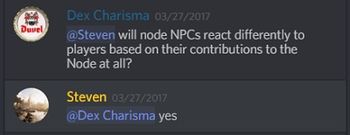
- ↑ Livestream, 17 November 2017 (29:45).
- ↑ 4.0 4.1 Transmissão ao vivo, 2020-06-26 (45:32).
- ↑ Transmissão ao vivo, 2018-02-09 (33:50).
- ↑ Blog - Know Your Nodes - The Basics.
- ↑ Blog - Know Your Nodes - Advance and Destroy.
- ↑ 8.0 8.1 8.2 8.3 8.4 8.5 Transmissão ao vivo, 2018-09-27 (53:06).
- ↑ 9.0 9.1 Entrevista, 2018-05-11 (54:34).
- ↑ Transmissão ao vivo, 2017-05-26 (21:23).
- ↑ 11.0 11.1 Entrevista, 2018-05-11 (47:27).
- ↑ 12.0 12.1 Entrevista, 2018-05-11 (1:00:19).
- ↑ Transmissão ao vivo, 2020-05-29 (1:00:57).
- ↑ Transmissão ao vivo, 2018-08-17 (16:00).
- ↑ Transmissão ao vivo, 2019-05-30 (1:26:16).
- ↑ 16.0 16.1 Entrevista, 2020-07-08 (55:05).
- ↑ 17.0 17.1 17.2 Transmissão ao vivo, 2017-05-10 (16:36).
- ↑ 18.0 18.1 Transmissão ao vivo, 2017-05-10 (35:16).
- ↑ 19.0 19.1 19.2

- ↑

- ↑ Transmissão ao vivo, 2017-10-16 (59:39).
- ↑ 22.0 22.1

- ↑

- ↑ Transmissão ao vivo, 2017-05-24 (37:05).
- ↑ 25.0 25.1 25.2 25.3 Entrevista, 2023-07-09 (1:37:34).
- ↑ 26.0 26.1 26.2 Transmissão ao vivo, 2017-05-09 (28:57).
- ↑ 27.0 27.1 27.2 Transmissão ao vivo, 2017-11-17 (11:00).
- ↑ 28.0 28.1 28.2 Vídeo, 2023-11-30 (30:19).
- ↑ 29.0 29.1 29.2 Twitter - Steven Sharif - Spatial inventory slots.
- ↑ 30.0 30.1 30.2 30.3 Transmissão ao vivo, 2023-02-24 (54:55).
- ↑ Transmissão ao vivo, 2020-05-29 (1:27:18).
- ↑ Vídeo, 2023-11-30 (13:38).
- ↑

- ↑ Transmissão ao vivo, 2023-02-24 (22:57).
- ↑ 35.0 35.1 35.2 Transmissão ao vivo, 2020-07-25 (1:14:13).
- ↑ 36.0 36.1 36.2 Transmissão ao vivo, 2023-11-30 (1:29:18).
- ↑ 37.0 37.1 37.2 37.3 37.4 Transmissão ao vivo, 2023-06-30 (1:24:42).
- ↑ Transmissão ao vivo, 2023-06-30 (46:17).
- ↑ Vídeo, 2023-06-30 (8:54).
- ↑ Podcast, 2023-07-15 (22:57).
- ↑ 41.0 41.1 41.2 Entrevista, 2023-09-10 (47:13).
- ↑ Transmissão ao vivo, 2023-02-24 (46:15).
- ↑ Transmissão ao vivo, 2021-11-19 (40:53).
- ↑ Transmissão ao vivo, 2023-11-30 (1:34:08).
- ↑ 45.0 45.1 Transmissão ao vivo, 2022-07-29 (1:17:33).
- ↑ Transmissão ao vivo, 2017-07-18 (44:57).
- ↑ Know Your Nodes: Economic Node Type.
